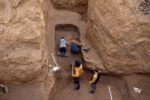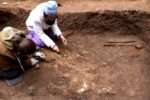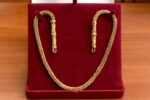 Archaeologists have discovered an unusual resident in a Scythian burial mound in Rostov, southwestern Russia: a warrior from the Southern Urals. He was buried with an Scythian leader in the 4th century B.C., but the central burial was looted in antiquity leaving his bodyguard as the stand-out discovery.
Archaeologists have discovered an unusual resident in a Scythian burial mound in Rostov, southwestern Russia: a warrior from the Southern Urals. He was buried with an Scythian leader in the 4th century B.C., but the central burial was looted in antiquity leaving his bodyguard as the stand-out discovery.
The presence of the burial mound was first noted by archaeologists in 1976, but thorough professional excavations only began last September. An initial geophysical survey revealed that the mound contained a profusion of burials from different periods, and the subsequent excavation confirmed the range of dates, with the oldest artifact a stone axe from the Cimmerian period (8th-7th centuries B.C.).
 When the archaeologists reached the central burial 18 feet below the surface, all that was left of the Scythian ruler buried there was one skull. Of his grave goods, only five amphorae remained. The plunderers missed his attendant, however. The man was exceptionally tall, about 6’6″, and his skeletal remains indicate he was ritually killed to accompany his master in death.
When the archaeologists reached the central burial 18 feet below the surface, all that was left of the Scythian ruler buried there was one skull. Of his grave goods, only five amphorae remained. The plunderers missed his attendant, however. The man was exceptionally tall, about 6’6″, and his skeletal remains indicate he was ritually killed to accompany his master in death.
 His burial was richly furnished. He wore a very fine gold chain, and a full complement of weapons were by his side: a slingshot, a quiver, arrows, two spears, darts and iron sword with a hilt wrapped in gold foil. There is also a Greek lekythos vessel for incense or oil. Above him are the remains of a horse.
His burial was richly furnished. He wore a very fine gold chain, and a full complement of weapons were by his side: a slingshot, a quiver, arrows, two spears, darts and iron sword with a hilt wrapped in gold foil. There is also a Greek lekythos vessel for incense or oil. Above him are the remains of a horse.
It was the sword that provided the first clue to the man’s origin. Even though the blade was heavily corroded, archaeologists identified it as a type  used by the nomadic peoples of the Southern Urals at that time. Other objects confirmed his origin. The horse wore a deer-shaped nosepiece typical of the Urals or Altai mountains. A large bronze cauldron with horizontal handles is also typical of the Southern Urals. Scythian cauldrons had vertical handles.
used by the nomadic peoples of the Southern Urals at that time. Other objects confirmed his origin. The horse wore a deer-shaped nosepiece typical of the Urals or Altai mountains. A large bronze cauldron with horizontal handles is also typical of the Southern Urals. Scythian cauldrons had vertical handles.
Sergey Lukyashko, Ph. D, professor from the Don State Technical University, commented on the find: “As we can see, this burial is not
typical. Here we see many eastern artefacts, but also objects from the Greek world. We have a hypothesis, that these people have come from the east, however, we cannot say for certain judging by just this one burial.”
The artefacts and the warlord’s remains will be sent for anthropological research to the Institute of Archaeology (Russian Academy of Sciences), where the scientists will determine the man’s age and place of birth.